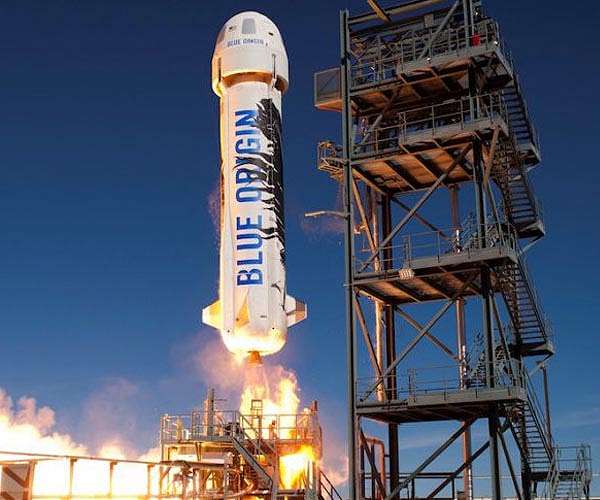
Blue Origin rocket suffers booster failure, prompting emergency abort system (Image Credit: Space Daily)
Blue Origin’s New Shepard rocket suffered a booster failure after lifting off Monday morning, causing an emergency abort system to separate the capsule from the booster.
The unmanned mission was carrying 36 payloads from academia, research institutions, and students across the globe and was expected to reach the edge of space and return in a series of suborbital flights.
It was the 23rd mission for the rocket, which has carried more than 150 commercial payloads including 18 on Monday’s flight funded by NASA.
The launch window opened at 8:30 a.m. CDT but a series of holds delayed the flight until just before 9:30 a.m., when the rocket lifted off from Launch Site One in Van Horn, Texas.
Flames could be seen on the live broadcast of the launch shooting from the booster just over a minute into the flight as the rocket pushed to Max Q, the point when aerodynamic stress on the vehicle reaches its maximum.
About 30 seconds later, the parachute system could be seen being deployed as the capsule drifted back for a soft landing on the ground.
“It appears we’ve experienced an anomaly with today’s flight. This was unplanned and we don’t have any details yet. But our crew capsule was able to escape successfully,” Erika Wagner, director of payload sales at Blue Origin, said during the live broadcast.
Blue Origin said in a statement on Twitter that the “capsule escape system functioned as designed.”
Commenters on the broadcast commended Blue Origin for how it handled the situation and congratulated the company for its successful in-flight escape.
“Every failure is a learning moment,” one comment reads.
The Federal Aviation Administration confirmed in an emailed statement to UPI that it will oversee an investigation of the Blue Origin mishap.
“The capsule landed safely and the booster impacted within the designated hazard area. No injuries or public property damage have been reported. This was a payload-only mission; there were no humans aboard,” the FAA said in the statement.
“Before the New Shepard vehicle can return to flight, the FAA will determine whether any system, process, or procedure related to the mishap affected public safety. This is standard practice for all mishap investigations.”
The FAA noted that it is “responsible for protecting the public during commercial space transportation launch and reentry operations.”
Related Links
Rocket Science News at Space-Travel.Com
|
|
Tweet |
|
|
|
We need your help. The SpaceDaily news network continues to grow but revenues have never been harder to maintain. With the rise of Ad Blockers, and Facebook – our traditional revenue sources via quality network advertising continues to decline. And unlike so many other news sites, we don’t have a paywall – with those annoying usernames and passwords. Our news coverage takes time and effort to publish 365 days a year. If you find our news sites informative and useful then please consider becoming a regular supporter or for now make a one off contribution. |
||
|
SpaceDaily Monthly Supporter $5+ Billed Monthly |
SpaceDaily Contributor $5 Billed Once credit card or paypal |
|
Teams continue to review options for next Artemis I launch attempt
Kennedy Space Center FL (SPX) Sep 07, 2022
After standing down on Saturday’s Artemis I launch attempt when engineers could not overcome a hydrogen leak in a quick disconnect, an interface between the liquid hydrogen fuel feed line and the Space Launch System (SLS) rocket, mission managers met and decided they will forego additional launch attempts in early September.
Over the next several days, teams will establish access to the area of the leak at Launch Pad 39B, and in parallel conduct a schedule assessment to provide additional data tha … read more









